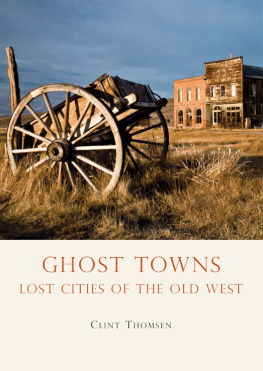



GHOST TOWNS
of
ROUTE

Text by Jim Hinckley
Photography by Kerrick James



Sun lights the front of a stone building in Afton, Oklahoma.
Page 1: Route 66 in Ludlow, California.
Page 2: Ruins in Jericho, Texas.
Page 3: Windswept clouds over a vintage Packard in Endee, New Mexico.
Page 4: A gas pump in Funks Grove, Illinois.
Opposite: A vintage car parked at Hackberry General Store in Arizona.
Page 11: Faded memories and faded signs are the silent monuments in Newkirk, New Mexico.
First published in 2011 by Voyageur Press, an imprint of MBI Publishing Company,
400 First Avenue North, Suite 300, Minneapolis, MN 55401 USA
Text copyright 2011 by Jim Hinckley
Photography copyright 2011 by Kerrick James
All rights reserved. With the exception of quoting brief passages for the purposes of review, no part of this publication may be reproduced without prior written permission from the Publisher.
The information in this book is true and complete to the best of our knowledge. All recommendations are made without any guarantee on the part of the author or Publisher, who also disclaims any liability incurred in connection with the use of this data or specific details.
We recognize, further, that some words, model names, and designations mentioned herein are the property of the trademark holder. We use them for identification purposes only. This is not an official publication.
Voyageur Press titles are also available at discounts in bulk quantity for industrial or sales-promotional use. For details write to Special
Sales Manager at MBI Publishing Company, 400 First Avenue North, Suite 300, Minneapolis, MN 55401 USA.
To find out more about our books, visit us online at www.voyageurpress.com.
Digital edition: 978-1-61060-247-1
Softcover edition: 978-0-76033-843-8
Library of Congress Cataloging-in-Publication Data
Hinckley, James, 1958
Ghost towns of Route 66 / text by Jim Hinckley ; photography by Kerrick James.
p. cm.
Includes bibliographical references and index.
ISBN 978-0-7603-3843-8 (plc)
1. West (U.S.)Description and travel. 2. United States Highway 66Description and travel. 3. Ghost townsWest (U.S.) 4. Ghost townsWest (U.S.)Pictorial works. 5. West (U.S.)History, Local. 6. West (U.S.)History, LocalPictorial works. I. James, Kerrick. II. Title.
F595.3.H55 2011
978dc22
2010037770
Edited by Danielle Ibister
Design Manager: Katie Sonmor
Designed by Isolde Maher/4 Eyes Design
Cover designed by John Barnett/4 Eyes Design
Printed in China
To the one who has been my source of encouragement and inspiration for more than two decades, my dearest friend, my wife.
J. H.
To Julie Ann Quarry, who made the miles less lonely and the route traveled never far from her heart and smile.
K. J.
CONTENTS


A roadside ghost in Plano, Missouri.
INTRODUCTION
I CONIC R OUTE 66 is more than a mere highway that connects a metropolis on the shore of Lake Michigan with a metropolis on the Pacific coast. It is the stuff of dreams. It is an icon of epic proportions that lures travelers from throughout the world to come experience American life as it once was and to seek the roadside ghosts from an era when Studebakers still rolled from the factory in South Bend.
The old highway is more than a 2,291-mile (according to a 1936 map) ribbon of asphalt lined with dusty remnants, ghostly vestiges, and polished gems manifesting more than eighty years of American societal evolution. Along Route 66, from Chicago to the shores of the Pacific Ocean at Santa Monica in California, whispering breezes carry the voices of ghosts from the Civil War that blend with those of French explorers, Native Americans, Spanish conquistadors, and pioneers fulfilling a young nations Manifest Destiny.
To drive Route 66 is to follow the path of a new nation on its journey of westward expansion. The signs bearing the double six mark the path of an American highway that is but a modern incarnation of the Pontiac Trail, the Osage Trail, and the old Federal Wire Road; the Beale Wagon Road and the El Camino Real; the National Old Trails Highway; and the Santa Fe Trail.
This long and colorful history makes the ghost towns along Route 66 unique because they are ghosts of the modern era with roots that reach to the nations earliest history.
There are territorial-era mining towns where men who came West on horseback cheered Barney Oldfield and Louis Chevrolet as they roared through town. There are quiet farming villages that once played center stage in the bloody conflict of the Civil War and dusty, wide spots in the road where centuries-old churches cast shadows over the ruts of the Santa Fe Trail as well as the broken asphalt of Route 66.
In the ghost towns of Route 66, the old road will forever be Americas Main Street. In the empty places along Americas most famous highway, the ghosts whisper on every breeze, and the swirling sands of time blur the line between past and present.



ILLINOIS

At Sheas in Springfield, Bill Shea has created a shrine to the gas station, the oil company, and the American love affair with the road trip.

In Funks Grove, the bucolic world of the nineteenth century blends seamlessly with the world of the Model T, with Route 66, and with the modern era of the mini van.
R OADSIDE GHOSTS and roadside time capsules abound in Illinois, but ghost towns are a rarity and are of a different nature than those found farther west on the plains and desert sands. The rising tide of urban sprawl that spawned the interstate highway and that swept Route 66 from center stage during the last half of the twentieth century began here with the transformation of the venerable two-lane into a four-lane super slab.
Next page




















